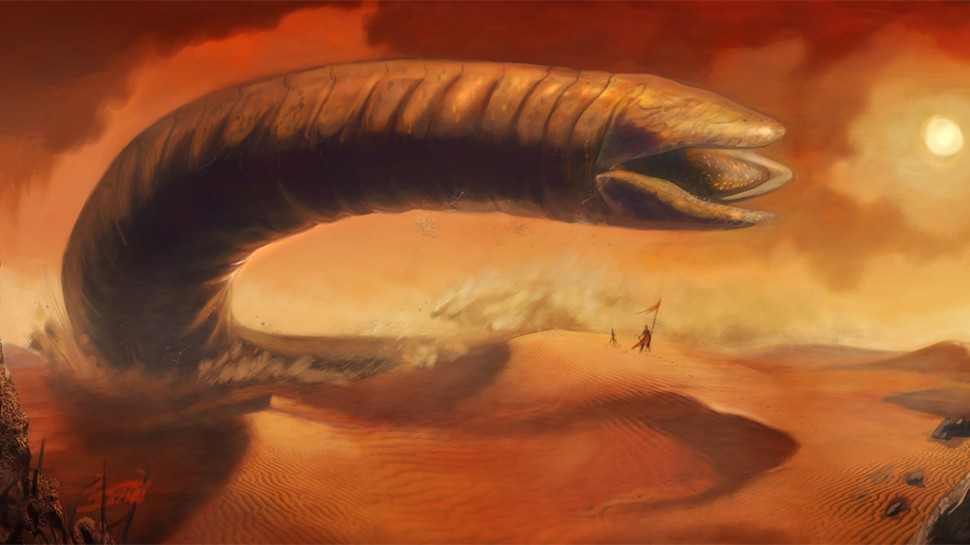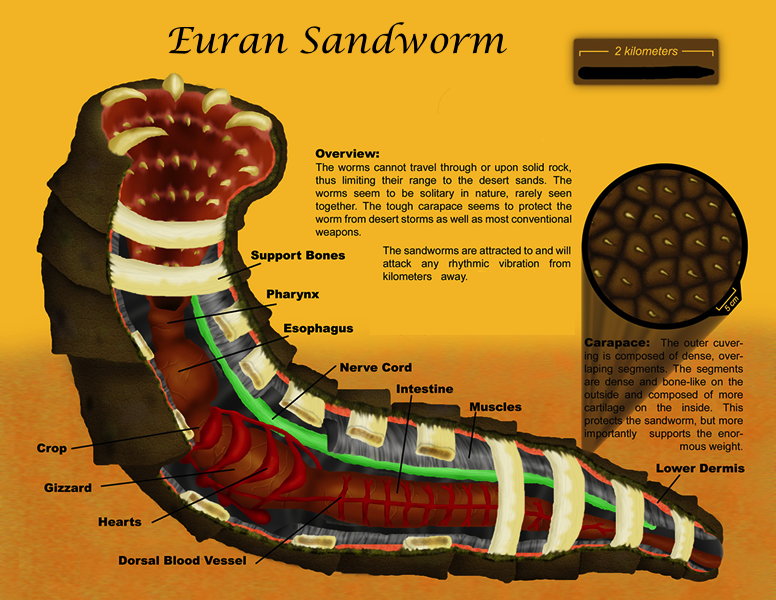Sandworm
A sandworm is a desert-dwelling worm that exists only on the continent of Eura. Their numbers are generally small but scientists have been unable to gather sufficient data to confirm any conclusive population data. The worms have been reported since ancient times and played an important role in Babkhan culture and mythology. At one point the worms were even bred and used as military steeds, with Babkhan going so far as to designate a large tract of desert as a conservation area for their protection. The worms generally reside in the harshest deserts of Eura, located primarily in the southern half of the continent. The greatest number of sightings are generally attributed to the Badbakhti Desert and Zsharra Desert. Virtually indestructible and with indefinite lifespans of potentially thousands of years, the giant sandworms are also referred to as the "Old Man of the Desert", "Old Father Eternity" and "Grandfather of the Desert".
Physiology
Sandworms are animals similar in appearance to colossal terrestrial annelids and in other ways to the lamprey. They are cylindrical worm-like creatures with a fearsome array of crystalline teeth that are used primarily for rasping rocks and sand. The mouth can achieve a diameter of some eighty meters in diameter.
Sandworms grow to hundreds of meters in length, with specimens observed over 400 metres (1,300 ft) long[3][5] and 40 metres (130 ft) in diameter, though smaller specimans of around half a league (2,778 meters) are not uncommon. These gigantic worms burrow deep in the ground and travel swiftly, grinding up larger rocks as they go, and increasing the volume of sand in the desert.
Sandworms are described as incredibly tough, with the only known means of death being by electrical shock or atomic weapons. Water is poisonous to the worms, but is typically difficult to find in the deep desert to be of use against any but the smallest of them.
Life cycle
Microscopic creatures called sand plankton feed upon traces of detritus scattered by sandworms on the Euran sands. The sand plankton are food for the giant sandworms, but also grow and burrow to become what are called Little Makers, "the half-plant-half-animal deep-sand vector of the sandworm".
The leathery Little Makers slowly emerge as sandtrout, a creature that looks something like a cross between fish and worm. These "sandtrout" block off water into fertile pockets within the porous lower strata, and when linked edge to edge against the planet's bedrock, form living cisterns. The cisterns act as a repellent to adult sandworms, and serve as food for the sandtrout. They are very sensitive to environmental changes though, and therefore have a high mortality rate. The few survivors entered a semidormant cyst-hibernation to emerge in six years as small (about three meters long) sandworms. A small number of these then emerge into maturity as giant sandworms, to whom water is poisonous.
While sandworms are capable of eating humans, the latter do contain a level of water beyond the preferred tolerances of the worms. They routinely devour metal equipment — mistaking the mechanical rhythm for prey — but they only seem to derive actual nutrition from sand plankton and smaller sandworms. Sandworms will not attack sandtrout.

